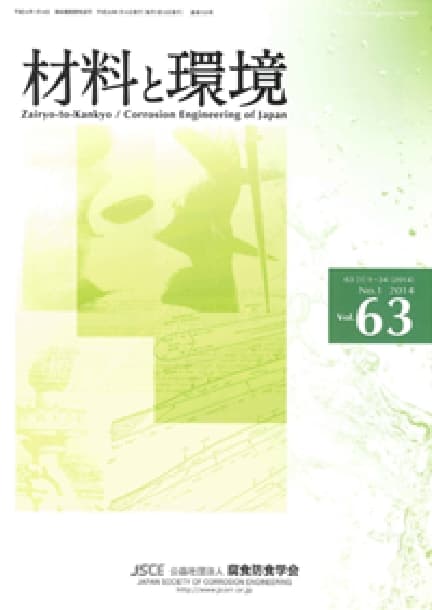- TOP
- Zairyo-to-Kankyo
- Vol. 58 (2009), No. 12
Zairyo-to-Kankyo Vol. 58 (2009), No. 12
Backnumber
-
Vol. 74 (2025)
-
Vol. 73 (2024)
-
Vol. 72 (2023)
-
Vol. 71 (2022)
-
Vol. 70 (2021)
-
Vol. 69 (2020)
-
Vol. 68 (2019)
-
Vol. 67 (2018)
-
Vol. 66 (2017)
-
Vol. 65 (2016)
-
Vol. 64 (2015)
-
Vol. 63 (2014)
-
Vol. 62 (2013)
-
Vol. 61 (2012)
-
Vol. 60 (2011)
-
Vol. 59 (2010)
-
Vol. 58 (2009)
-
Vol. 57 (2008)
-
Vol. 56 (2007)
-
Vol. 55 (2006)
-
Vol. 54 (2005)
-
Vol. 53 (2004)
-
Vol. 52 (2003)
-
Vol. 51 (2002)
-
Vol. 50 (2001)
-
Vol. 49 (2000)
-
Vol. 48 (1999)
-
Vol. 47 (1998)
-
Vol. 46 (1997)
-
Vol. 45 (1996)
-
Vol. 44 (1995)
-
Vol. 43 (1994)
-
Vol. 42 (1993)
-
Vol. 41 (1992)
-
Vol. 40 (1991)
Keyword Ranking
13 Dec. (Last 30 Days)
Zairyo-to-Kankyo Vol. 58 (2009), No. 12
Effect of Initial Films of Copper on Moundless Type Pitting Corrosion of Copper Tubes
Masahiro Sakai, Osami Seri
pp. 434-440
DOI:
10.3323/jcorr.58.434Abstract
Copper tubes were immersed for one year in fifteen kinds of synthetic freshwater to reproduce a moundless type pitting corrosion. Most or part of the area of some specimen surfaces changed its color into dark brown for about one week immersion. Such a dark brown area formed in freshwater for about one week immersion is called “initial film” of a copper. The formation of the initial film was accelerated in the test water containing a chloride ion. After one-year immersion tests, moundless type pitting corrosion occurred on the specimen immersed in the test water containing 40 mg SiO2/L, 50 mg SO42−/L, 10 mg Cl−/L and 10 mg HCO3−/L. These pits were located on the boundary of the initial film. The initial film was formed intentionally by one-week immersion in the solution containing silica and chloride ion. Cathodic reductions of the initial film revealed that the thickness of the initial film was about 400 nm of cuprous oxide. The galvanic corrosion test was performed using galvanic couples of a copper tube with the initial film and an as-received copper tube. The galvanic current flew from the copper tube with initial film to the as-received copper tube. This result indicates that the macro-cell formation of the area with an initial film and the area without an initial film causes the moundless type pits on the boundary of the initial film.
Development of a New Design for Corrosion Prevention in NH4HS Environments
Kazuhiro Toba, Koji Kawano, Jun'ichi Sakai
pp. 441-447
DOI:
10.3323/jcorr.58.441Abstract
NH4HS corrosion has been a serious problem in oil refining plants. The corrosion rate dramatically increases over a certain concentration of NH4HS. In high pressure plants such as hydrodesulfurization units which are operating in NH4HS environments, leakage caused by corrosion could result in catastrophic disaster. Therefore, in the design phase, corrosion prevention techniques should be considered. In this study, a new design philosophy to prevent NH4HS corrosion in a sour water environment was successfully developed based on simulation techniques.
Article Access Ranking
13 Dec. (Last 30 Days)
-
Delayed Fracture Mechanism of 1700 MPa-Class Quenched and Tempered Bolt under Atmospheric Corrosion Environment
Tetsu-to-Hagané Advance Publication
-
Perspectives on the Promising Pathways to Zero Carbon Emissions in the Steel Industry toward 2050
ISIJ International Vol.65(2025), No.2
-
Effect of B on Surface Oxidation Behavior and Phosphatability of Si-Mn-added Cold-Rolled Steel Sheets
ISIJ International Advance Publication
-
Factors Influencing the Bonding Phase Structure of Iron Ore Sinters
ISIJ International Vol.43(2003), No.9
-
Effect of microstructural heterogeneity on fatigue limit of as-quenched low-carbon low-alloy martensitic steel
ISIJ International Advance Publication
-
Prussian blue as a fully reversible hydrogenochromic material for visualizing hydrogen distribution in Fe sheet
ISIJ International Advance Publication
-
Progress of Strip Casting Technology for Steel; Historical Developments
ISIJ International Vol.52(2012), No.12
-
Research Progress on Optimal Blending of Iron Ore Powders for Sintering
ISIJ International Vol.65(2025), No.12
-
-
Microstructures and Reduction Properties of High CaO Concentration Sintered Ore
ISIJ International Advance Publication
You can use this feature after you logged into the site.
Please click the button below.










